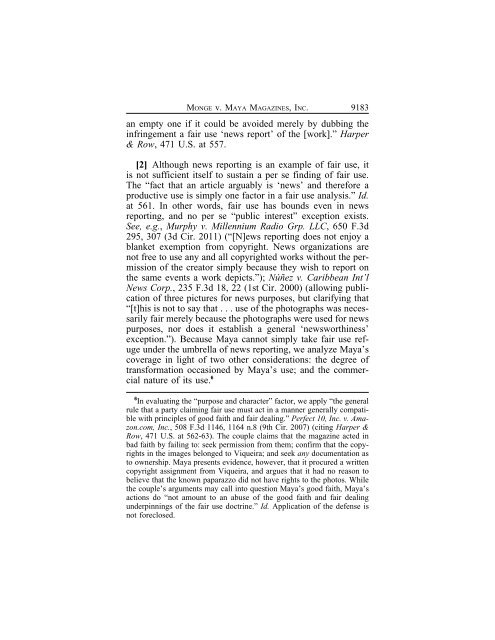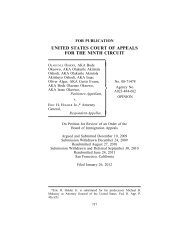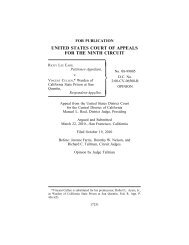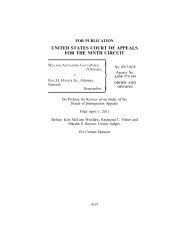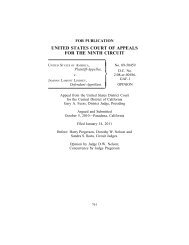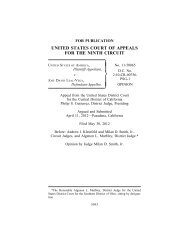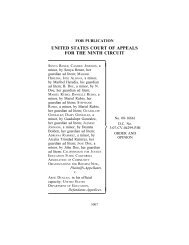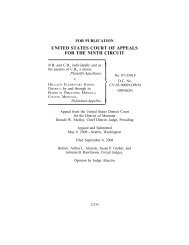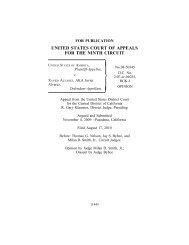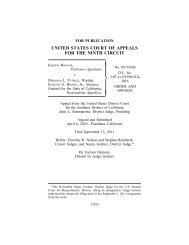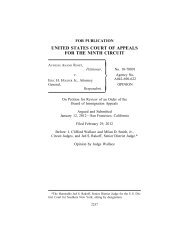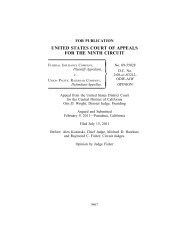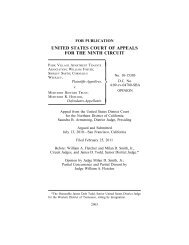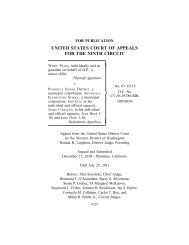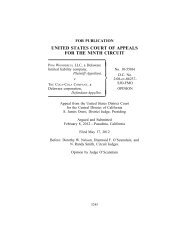NOELIA MONGE V. MAYA MAGAZINES, INC. - Ninth Circuit Court of ...
NOELIA MONGE V. MAYA MAGAZINES, INC. - Ninth Circuit Court of ...
NOELIA MONGE V. MAYA MAGAZINES, INC. - Ninth Circuit Court of ...
You also want an ePaper? Increase the reach of your titles
YUMPU automatically turns print PDFs into web optimized ePapers that Google loves.
<strong>MONGE</strong> v. <strong>MAYA</strong> <strong>MAGAZINES</strong>, <strong>INC</strong>.<br />
9183<br />
an empty one if it could be avoided merely by dubbing the<br />
infringement a fair use ‘news report’ <strong>of</strong> the [work].” Harper<br />
& Row, 471 U.S. at 557.<br />
[2] Although news reporting is an example <strong>of</strong> fair use, it<br />
is not sufficient itself to sustain a per se finding <strong>of</strong> fair use.<br />
The “fact that an article arguably is ‘news’ and therefore a<br />
productive use is simply one factor in a fair use analysis.” Id.<br />
at 561. In other words, fair use has bounds even in news<br />
reporting, and no per se “public interest” exception exists.<br />
See, e.g., Murphy v. Millennium Radio Grp. LLC, 650 F.3d<br />
295, 307 (3d Cir. 2011) (“[N]ews reporting does not enjoy a<br />
blanket exemption from copyright. News organizations are<br />
not free to use any and all copyrighted works without the permission<br />
<strong>of</strong> the creator simply because they wish to report on<br />
the same events a work depicts.”); Núñez v. Caribbean Int’l<br />
News Corp., 235 F.3d 18, 22 (1st Cir. 2000) (allowing publication<br />
<strong>of</strong> three pictures for news purposes, but clarifying that<br />
“[t]his is not to say that . . . use <strong>of</strong> the photographs was necessarily<br />
fair merely because the photographs were used for news<br />
purposes, nor does it establish a general ‘newsworthiness’<br />
exception.”). Because Maya cannot simply take fair use refuge<br />
under the umbrella <strong>of</strong> news reporting, we analyze Maya’s<br />
coverage in light <strong>of</strong> two other considerations: the degree <strong>of</strong><br />
transformation occasioned by Maya’s use; and the commercial<br />
nature <strong>of</strong> its use. 6<br />
6 In evaluating the “purpose and character” factor, we apply “the general<br />
rule that a party claiming fair use must act in a manner generally compatible<br />
with principles <strong>of</strong> good faith and fair dealing.” Perfect 10, Inc. v. Amazon.com,<br />
Inc., 508 F.3d 1146, 1164 n.8 (9th Cir. 2007) (citing Harper &<br />
Row, 471 U.S. at 562-63). The couple claims that the magazine acted in<br />
bad faith by failing to: seek permission from them; confirm that the copyrights<br />
in the images belonged to Viqueira; and seek any documentation as<br />
to ownership. Maya presents evidence, however, that it procured a written<br />
copyright assignment from Viqueira, and argues that it had no reason to<br />
believe that the known paparazzo did not have rights to the photos. While<br />
the couple’s arguments may call into question Maya’s good faith, Maya’s<br />
actions do “not amount to an abuse <strong>of</strong> the good faith and fair dealing<br />
underpinnings <strong>of</strong> the fair use doctrine.” Id. Application <strong>of</strong> the defense is<br />
not foreclosed.


